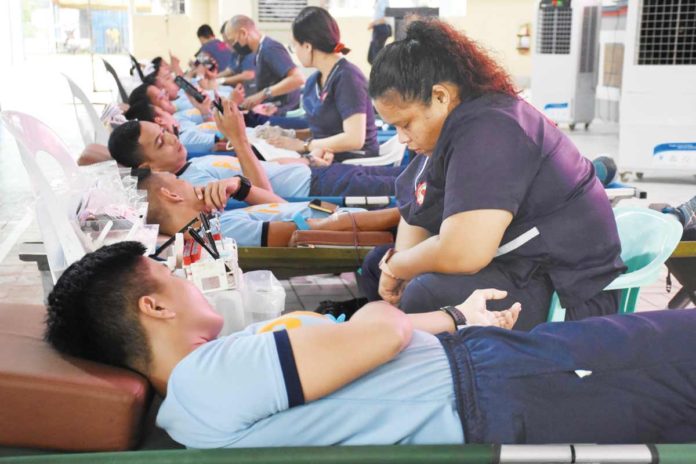
ILOILO City – Regular monitoring at blood banks in tertiary hospitals across Western Visayas has not yet indicated a shortage of blood products across six provinces and highly urbanized cities, despite the ongoing rise in dengue cases.
The Department of Health (DOH) is closely monitoring the supply of blood products in the region, said Dr. Bea Camille Natalaray, medical officer IV and head of the Emerging and Re-Emerging Infectious Disease (EREID) at DOH Region 6.
Blood products such as whole blood, packed red blood cells, and platelet concentrate are frequently administered to dengue patients admitted to health facilities.
Dengue is a mosquito-borne viral infection causing a severe flu-like illness, and sometimes leading to severe complications such as hemorrhaging and shock, particularly in severe forms like dengue hemorrhagic fever.
The most recent inventory (August 26) showed the region with 582 units of whole blood, 1,001 units of packed red blood cells, and 101 units of platelet concentrate available, said Natalaray.
Dengue patients may require blood transfusions for a few reasons, primarily due to complications that can arise from the infection. The disease can cause a significant drop in platelet count (thrombocytopenia), which are components of the blood that help with clotting. When platelet levels fall too low, there is a risk of severe bleeding (hemorrhaging), and transfusions of platelets can be necessary to prevent this.
If the patient experiences internal or external bleeding, blood transfusions (using whole blood or packed red blood cells) may be needed to replace the lost blood and maintain adequate hemoglobin levels, which are crucial for carrying oxygen in the blood.
Also, dengue hemorrhagic fever, a severe form of dengue, can lead to leakage of blood plasma outside of small blood vessels, potentially resulting in shock (dengue shock syndrome). Blood products might be used to manage and stabilize the patient’s condition in such cases.
Regarding the bed utilization rate for hospitals in the region, including dengue patients, currently stands at 72.04 percent, added Natalaray.
With the increase in dengue cases, DOH-6 has reiterated the use of Data Collect Hubs (bed-tracker) across all hospitals and infirmaries to ensure the proper monitoring and accounting of dengue patients.
Guidelines for managing surge capacity during the dengue epidemic have also been reiterated.
To streamline the handling of dengue patients, health facilities in the region have re-established dengue fast lanes and continue to monitor outbreaks in the provinces and highly urbanized cities.
As of now, DOH-6 has distributed various logistics to Provincial or City Health Offices (P/CHOs) including 7,750 mosquito nets, 3,400 olyset rolls, 10,200 sachets of bistar for indoor and outdoor residual spraying, and 504 bottles of metofluthrin.
Additionally, 200,000 sachets of oral rehydration salts, 3,000 bottles each of dextrose in lactated ringers, and sodium chloride have been distributed.
From January 1 to August 17, 2024, the region has recorded 15,688 dengue cases with 31 deaths, a 199 percent increase compared to the same period in 2023, which saw 5,254 cases and 24 deaths.
The most recent week alone, from August 10 to August 17, saw 3,490 new cases.
The breakdown of the 3,490 new cases by province and highly urbanized city is as follows:
* Aklan – 258 cases
* Antique – 183 cases
* Capiz – 330 cases
* Guimaras – 408 cases
* Iloilo – 1,315 cases
* Iloilo City – 253 cases
* Negros Occidental – 547 cases
* Bacolod City – 196 cases
The total cases this year per province and city are:
* Aklan – 1,766 cases with one death
* Antique – 942 cases with one death
* Capiz – 1,581 cases with five deaths
* Guimaras – 1,320 cases with one death
* Iloilo – 6,069 cases with 13 deaths
* Iloilo City – 945 cases with three deaths
* Negros Occidental – 2,418 cases with six deaths
* Bacolod City – 647 cases with one death
The most affected age group remains those aged 11 to 20 years, comprising 34.2 percent of the total cases, followed by children aged 1 to 10 years at 32 percent; 21 to 30 years old (17 percent); 31 to 40 years old (6.4 percent); age 51 years old and above ( 5.1 percent); and 41 to 50 years old (2.8 percent).
The region has identified 897 barangays with clustering of cases, defined as having three or more cases within a four-week period – Aklan (79 barangays), Antique (36 barangays), Capiz (93 barangays), Guimaras (63 barangays), Iloilo (388 barangays), Iloilo City (77 baramgau), Negros Occidental (1 37), and Bacolod City (24)./PN



